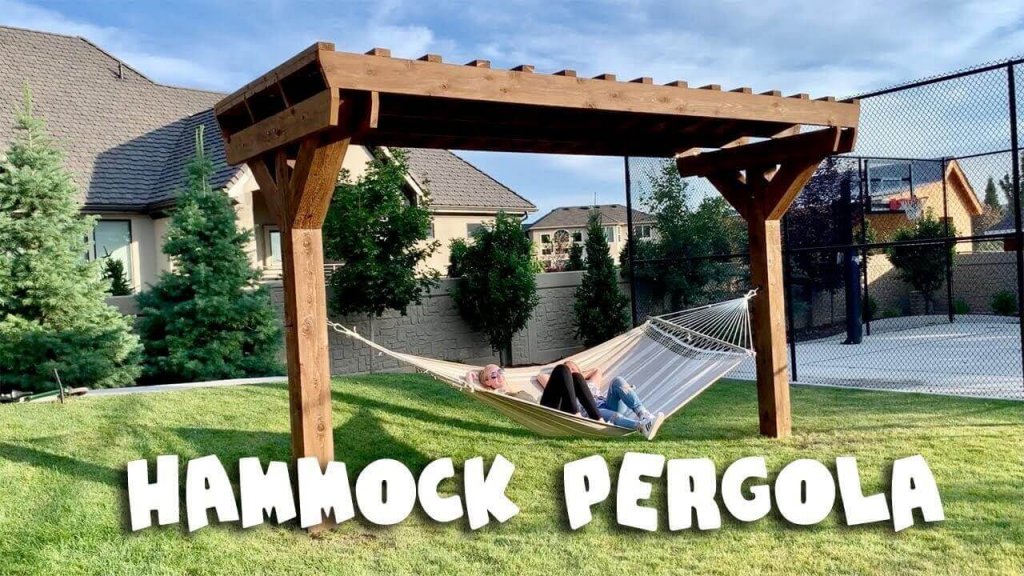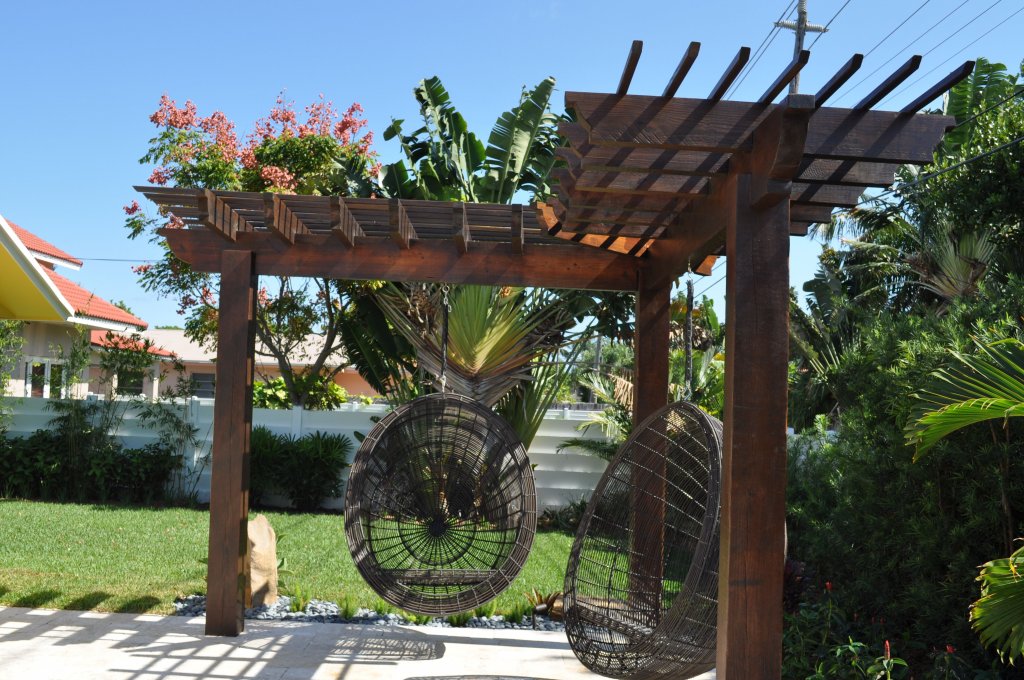- 8 Airplane Footrest Hammock!Travel comfortably - October 9, 2023
- top 7 Pool Float Water Hammock for a Relaxing Summer - October 9, 2023
- top 5 Space SaverSingle Hammock Stand Maximize Comfort and Space - October 9, 2023
When it comes to finding the perfect blend of comfort and shelter, hanging a hammock in a gazebo can be a brilliant solution.
Picture yourself gently swaying in a hammock, surrounded by the beauty of your garden, while also enjoying the protection provided by a gazebo.
However, before you embark on this enticing endeavor, it’s crucial to understand the importance of proper installation and safety considerations. In this article, we will explore the steps and factors to consider when hanging a hammock in your gazebo to create the ultimate relaxation spot.
How to Install a Hammock Video Tutorial:
- Measure the distance between the two posts of your gazebo
- This will be the length of your hammock
- Cut two lengths of rope, each twice the length of the distance between the posts
- Tie one end of each rope to a post
- Tie the other end of each rope to the ends of your hammock
- Hang your hammock from the ropes, and enjoy!
Understanding Your Gazebo and Hammock
Gazebos are versatile outdoor structures that provide a shaded area for relaxation and entertainment. There are different types of gazebos, each with its own unique structure and purpose. Open-air gazebos are typically freestanding structures with a roof supported by columns or posts.
They offer a spacious and airy environment, perfect for hosting events or enjoying outdoor dining. Enclosed gazebos, on the other hand, have walls or screens that provide protection from insects and adverse weather conditions.
These enclosed structures create a cozy space suitable for year-round use. Gazebos can be constructed from various materials such as wood, metal, or vinyl, each offering different aesthetic and durability qualities.
Hammocks are popular additions to outdoor spaces, offering a comfortable and relaxing spot to lounge and unwind. There are several types of hammocks available, including rope hammocks, fabric hammocks, and hammocks with different hanging styles.
Rope hammocks are traditionally made from cotton or polyester ropes, providing a classic look and allowing for increased airflow.
Fabric hammocks, on the other hand, are made from durable materials such as canvas or nylon, providing a more comfortable and supportive surface. Hammocks can be hung between trees, posts, or using stands specifically designed for hammocks.
Before attempting to hang a hammock in your gazebo, it is essential to know the specifications and limitations of both your gazebo and hammock.
Understanding the weight capacity and structural integrity of your gazebo will ensure that it can safely support the weight of the hammock and its occupants.
Additionally, knowing the dimensions of your gazebo and the available hanging points will help you determine the appropriate size and style of the hammock.
Considering factors such as the height, width, and material of your hammock, as well as the desired hanging style, will ensure a secure and comfortable setup.
By understanding these specifications and limitations, you can enjoy your gazebo and hammock safely and maximize your outdoor relaxation experience.
Assessing the Feasibility
When it comes to creating a cozy and relaxing spot in your garden, hanging a hammock from your gazebo can be a fantastic idea.
However, before you proceed with this plan, it’s crucial to assess the feasibility of such an installation to ensure both safety and durability.
To begin, consider the weight capacity and structural integrity of your gazebo. Most gazebos are designed to support the weight of individuals sitting or standing inside, rather than handling the dynamic forces exerted by a hammock.
Check the manufacturer’s guidelines or consult with an expert to determine the weight limit your gazebo can bear.
Next, evaluate the available space and the suitability of your gazebo for hanging a hammock. Measure the distance between the gazebo’s poles or rafters, ensuring it is wide enough to accommodate the length of the hammock.
Additionally, inspect the materials used in constructing the gazebo. If it consists of sturdy wood or metal, it is more likely to support a hammock securely.
Remember, permanent installation may require additional hardware such as bolts and hooks for enhanced security. Consider purchasing high-quality hammock hooks or consult a professional for proper installation.
Always prioritize safety and ensure that your gazebo can handle the weight and motion associated with a hammock. With the right precautions, you can create a beautiful and relaxing oasis in your flower garden or backyard gazebo.
Choosing the Right Hammock
When it comes to hanging a hammock from your gazebo, choosing the right type of hammock is essential for a comfortable and secure experience. Let’s explore the different options available and consider important factors to help you make the best choice.
There are various types of hammocks suitable for gazebo installation, such as hammock chairs, single hammocks, and double hammocks. Hammock chairs are great if you prefer a sitting position, while single and double hammocks are perfect for lounging and relaxing.
When selecting a hammock, consider factors like weight capacity, size, material, and comfort. Ensure that the hammock’s weight capacity matches your requirements, and check if it can comfortably fit within the dimensions of your gazebo.
Look for high-quality materials like durable ropes and fabrics that can withstand outdoor conditions.
So go ahead, hang that hammock, and create a cozy haven in your gazebo for endless relaxation and enjoyment. Consider these shops, they have many nice products on offer.
Hammock Hanging Options
If you have a gazebo in your garden, you might be wondering if it’s possible to hang a hammock in it. The good news is that with the right tools and techniques, you can create a relaxing hammock haven within your gazebo. There are various options for hanging a hammock, and we’ll explore them here.
Hammock Straps
Using hammock straps is a popular and versatile option. These straps are typically made of strong, durable material and can be wrapped around trees, poles, or gazebo rafters. They provide a secure and adjustable attachment point for your hammock. Hammock straps are easy to set up and remove, making them a convenient choice.
Hoks and Mounting Hardware
Another option is to install hooks or mounting hardware in your gazebo. These can be attached to the gazebo’s poles, rafters, or even the wood structure itself.
It’s important to choose hooks or hardware specifically designed for hammock hanging, as they will provide the necessary strength and stability. This method offers a more permanent installation and ensures a secure attachment for your hammock.
Step-by-Step Installation
Regardless of the hanging option you choose, the installation process follows a similar pattern. Here’s a step-by-step guide to help you hang your hammock in a gazebo:
- Choose the Location: Select a suitable spot in your gazebo where you can hang the hammock without obstruction.
- Measure and Prepare: Measure the distance between the hanging points and ensure they are at an appropriate height for your hammock. Prepare the necessary tools and materials.
- Attach the Straps or Hooks: Depending on your chosen method, attach the hammock straps securely or install the hooks or mounting hardware at the designated points.
- Hang the Hammock: With the attachment points in place, hang your hammock using the straps, hooks, or mounting hardware. Make sure it is taut and evenly balanced.
- Test and Adjust: Before fully relaxing in your hammock, test its stability and adjust the hanging height or tension if needed. Ensure it feels secure and comfortable.
By following these steps and choosing the hanging method that suits your gazebo, you can create a tranquil space to unwind and enjoy the gentle sway of your hammock.
Remember, always prioritize safety when hanging your hammock, and regularly inspect the attachment points for any signs of wear or weakness. Now, go ahead and turn your gazebo into a hammock haven!
Safety Considerations for Hanging a Hammock in Your Gazebo
If you don’t have trees in your yard, don’t worry! You can still enjoy the relaxation of a hammock without them. There are a few different options for hanging a hammock without trees.
One option is to use hammock stands. Hammock stands are freestanding and can be placed wherever you want. They come in a variety of sizes and styles, so you can find one that fits your needs.
Another option is to use posts or other sturdy objects. You can sink posts into the ground or use other objects like fence posts or deck posts. Be sure to use heavy-duty hardware to secure the hammock.
You can also get creative and use things like tree stumps, large rocks, or even cars! If you’re using something like a stump or rock, be sure to secure the hammock so it doesn’t shift or move.Whatever option you choose, make sure you follow the manufacturer’s instructions for safe set up.
Then, sit back, relax, and enjoy your hammock without trees!
Maintenance and Care for Your Hammock and Gazebo
To ensure the longevity of your hammock and gazebo, proper maintenance and care are essential. Here are some tips to help you keep them in good condition:
- Cleaning Practices: Regularly clean your hammock according to the manufacturer’s instructions. Use mild soap and water to remove dirt and stains. Allow it to air dry thoroughly before storage.
- Storage Precautions: When not in use, store your hammock in a dry and protected area. Avoid leaving it exposed to harsh weather conditions, which can cause damage over time. Consider using a hammock storage bag or cover for added protection.
- Gazebo Maintenance: Inspect your gazebo periodically for any signs of damage, such as loose screws or cracks in the structure. Tighten any loose connections and repair any damages promptly to prevent further deterioration.
- Regular Inspections: Regularly inspect both your hammock and gazebo for wear and tear. Check for fraying ropes, tears in the fabric, or signs of rust or corrosion on the gazebo. Address any issues promptly to avoid safety hazards and ensure the longevity of your setup.
comparison table highlighting some key features and differences between a hammock and a gazebo:
| Feature | Hammock | Gazebo |
|---|---|---|
| Purpose | Provides a comfortable outdoor resting/sleeping area | Offers shade, shelter, and a designated outdoor space |
| Structure | Consists of fabric suspended between two anchor points | A standalone outdoor structure with a roof and open sides |
| Material | Typically made of durable fabric or rope | Can be constructed from various materials such as wood, metal, or vinyl |
| Setup | Requires attachment to sturdy support points such as trees or posts | Requires assembly and installation according to manufacturer instructions |
| Portability | Can be easily taken down and transported | Generally not designed for portability |
| Functionality | Primarily used for relaxation and leisure | Offers a versatile outdoor space for various activities |
| Weather Resistance | Some hammocks are weather-resistant or come with a rainfly for protection | Gazebos provide better protection from the elements, including rain and sun |
| Cost | Hammocks can range from affordable to high-end options | Gazebos can vary significantly in price depending on size, materials, and features |
It’s important to note that this is a general comparison and individual hammocks and gazebos can have unique features and characteristics. When choosing between a hammock and a gazebo, consider your specific needs, preferences, and the intended use of the outdoor space.
Can a hammock be hung from a pergola?
Yes, a hammock can be hung from a pergola! There are a few things to keep in mind when hanging a hammock from a pergola, though. First, make sure that the pergola is sturdy and will be able to support the weight of the hammock and whoever is using it.
Second, use rope or straps that are rated for outdoor use to secure the hammock to the pergola. And lastly, be sure to test the hammock before using it to make sure it is secure and safe.
Can a patio support a hammock?
Yes, a patio can support a hammock! There are a few things to consider when hanging a hammock on your patio, though. First, make sure that your patio is structurally sound and can support the weight of the hammock and whoever is using it.
Second, consider where you want to hang the hammock. You’ll want to make sure there are two strong points to anchor the hammock to, and that the hammock is at a comfortable height for you to get in and out of. Finally, make sure the area around the hammock is clear so you have plenty of room to enjoy your relaxation time!
Can you hang a hammock without trees?
Hammocks are traditionally hung between two trees, but it is possible to hang a hammock without trees. There are a few different ways to do this. One option is to use hammock stands.
Hammock stands are freestanding frames that you can set up anywhere. They typically have two posts with hooks or loops for attaching your hammock. Some stands are adjustable, so you can change the distance between the posts to accommodate different hammock sizes.
Another option is to use posts or walls. If you have a deck or patio with railings, you can run a hammock rope over the top and secure it to the posts or walls. You can also use eye bolts or other types of hardware to secure the rope to a solid surface.
If you’re camping or hiking, you can use rocks, logs, or other large objects to anchor your hammock. Just be sure that whatever you use is sturdy and won’t move when you get in the hammock. With a little creativity, you can hang a hammock just about anywhere!
FAQ :
Can I hang a swing in my gazebo instead of a hammock?
What are the weight limits for different types of gazebos?
Are there any gazebo modifications required for hammock installation?
How do I ensure the hammock is properly balanced when hanging it?
Choose the right distance: Ensure the distance between the attachment points is appropriate for the length of your hammock.
Use level ground: Ensure the ground beneath the hammock is level to maintain balance.
Hang at proper height: Hang the hammock at a height that allows it to sag slightly when occupied but doesn’t touch the ground.
Equal tension: Ensure equal tension on both sides of the hammock to maintain balance.
Can I hang a hammock from a gazebo with a fabric roof?
Is it safe to leave a hammock hanging in a gazebo during bad weather?
What are the common mistakes to avoid when hanging a hammock in a gazebo?
Exceeding weight limits: Ensure that the combined weight of the hammock and occupants does not exceed the weight capacity of the gazebo.
Inadequate attachment points: Use appropriate hardware and attachment points to ensure a secure and stable hanging setup.
Improper balance: Ensure the hammock is properly balanced and not excessively sagging on one side.
Neglecting maintenance: Regularly inspect the hanging hardware and connections for signs of wear or damage.
Ignoring weather conditions: Avoid leaving the hammock hanging during bad weather, as it can cause damage to both the gazebo and the hammock.
How often should I check the hanging hardware and connections?
Are there any specific safety measures for hanging a hammock in an enclosed gazebo?
Adequate ventilation: Ensure that the enclosed gazebo has proper ventilation to prevent heat buildup and maintain a comfortable environment.
Check height clearance: Make sure the hammock is hung at an appropriate height, taking into account the height of the enclosure, to avoid any collisions with the ceiling.
Secure attachment points: Ensure that the attachment points for the hammock are securely anchored to the structure of the enclosed gazebo, taking into account the additional stress caused by the enclosure.
Regular inspections: Conduct regular inspections of the hanging hardware, connections, and the overall conditio
Can I hang a hammock with a stand inside a gazebo?
In conclusion, hanging a hammock in your gazebo offers a delightful combination of relaxation and shelter.
By understanding the specifications of your gazebo and hammock, assessing feasibility, selecting the right hammock, exploring different hanging options, prioritizing safety, and practicing proper maintenance,
you can create a serene oasis where you can unwind and enjoy the beauty of your garden.
So, go ahead and integrate a hammock into your gazebo to experience the ultimate bliss of leisure in your outdoor haven.







Pingback: 11 Tips Avoid Flipping Your Hammock In Windy Conditions.